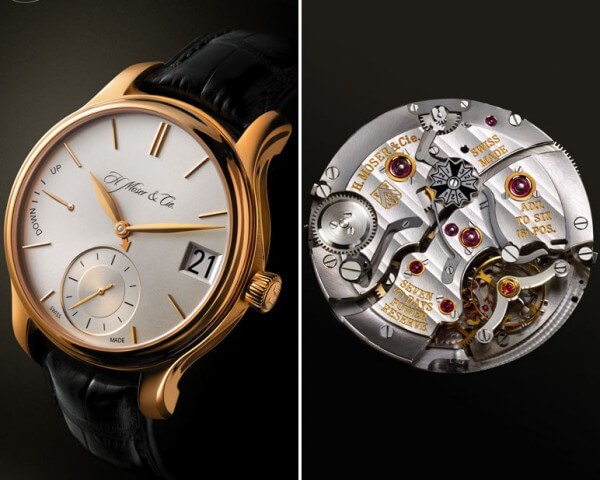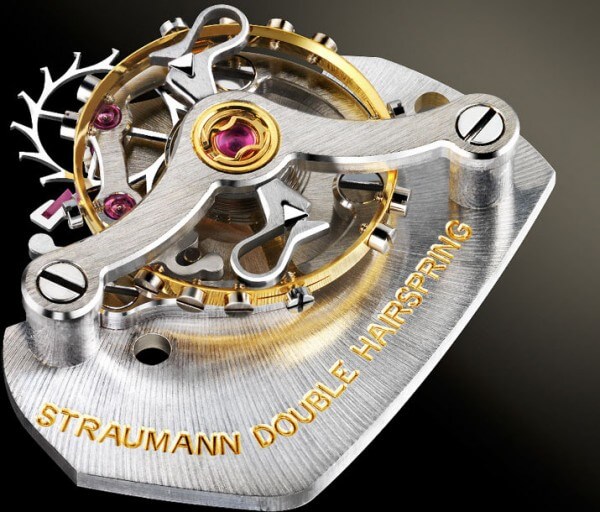Almost five years ago in 2005, H. Moser & Cie re-emerged on the international horological stage. Dr. Jürgen Lange, a technical director at IWC, and Roger Nicholas Balsiger, the great grandson of Heinrich Moser, resurrected the brand with a small pool of private investors. A lot of watch companies trumpet their arrival and accomplishments with a lot of fanfare. Not so with H. Moser & Cie. Their entrance was understated and dignified, and might have even escaped your notice. Dr. Lange says, “We came out with very elegant, quiet, well-priced yet technically exclusive watches, when everybody else was going towards more complications, bigger sizes, brighter colors and rather crazy prices.”
Clever interpretations of challenging problems
Among other dials, Moser watches present a modest face for the level of mechanics housed within. Oftentimes the simplest and most obvious advances are the easiest to overlook. At Moser, they have a knack for implementing clever and simple interpretations of challenging problems. Take, for example, the escapement. The regulating instrument of the movement, the escapement is primarily responsible for accurate timekeeping. This fussy mechanism can be the bane of the watchmaker during servicing. After disassembling and cleaning, the escapement must then be reset, which can be a time-consuming process, leaving the customer without a watch for a long period of time.
By mounting the entire mechanism on a separate plate, Moser circumvented this step in the process. Secured by two screws into the base, the piece links to the movement by the anchor wheel. When a watch comes in for service, the watchmaker exchanges the whole escapement out, replacing it with one that has been assembled and regulated at Moser’s factory in Schaffhausen.
The system of exchange might seem more suited for a lower end watch with disposable parts. But, this is far from the case. Moser constructs the escape wheel and pallet fork in solid gold and uses balance screws rather than an index to calibrate oscillations. More than just aesthetics, the gold proves a superior material in terms of reducing friction, and therefore allows greater precision and less wear to the parts. Moreover, in line with a worldwide conservation effort, the factory services the part to put back into rotation on another watch.
Moser’s perpetual calendar
Moser also achieved success with their perpetual calendar, which took first place in the complicated watches category at the Grand Prix D’Horlogerie de Geneve in 2006. The concept of a perpetual calendar usually conjures up images of a watch busy with windows and dials showing the day, date and leap year cycle. In the ingenious Perpetual 1, Moser represents the complication in a beautifully austere presentation. A large date grabs the eye in the traditional position at 3 o’clock, while one other smaller hand, concentric to those indicating hours and minutes, accounts for the twelve months. Balancing out the face are a seconds sub-dial at 6 o’clock and a state of wind gauge (indicating the level of the 7 day power reserve) opposite the date. The leap year indicator, located on a star-shaped wheel on the back of the movement, is easily set via a pin pusher.
In addition, the date, which can be adjusted both forwards and backwards, features a proprietary “Flash Calendar” display. Many perpetual date mechanisms pass through an intermediate stage when moving to a non-sequential number on the yearly calendar: for example, in the month change from February to March. The Perpetual 1 jumps seamlessly to the correct date.

The Straumann Double Hairspring escapement
In 2007, Moser introduced the Straumann Hairspring, made from a proprietary formula updated from Dr. h.c. Reinhard Straumann’s original alloy composition from 1931 named Nivarox. As Dr. Thomas Straumann, the great-grandson of Dr. h.c. Reinhard Straumann, sits on Moser’s board, the company gained the rights of manufacture. More significantly, Moser used the technology in service to the Straumann Double Hairspring Escapement, which debuted the same year.
While a balance spring composed of Nivarox, in conjunction with the bend of a Breguet terminal curve, does a good job of keeping the center of gravity at the center of the arbor, there still continues to be a small error. The tourbillon complication provides a compensatory mechanism, albeit a very expensive and complex one.
In typical Moser fashion, the watchmakers presented an equally efficient solution that is as graceful as it is simple. The Straumann Double Hairspring escapement mounts two balance springs onto the balance wheel. During oscillation the springs move on opposing symmetrical paths, effectively canceling out any gravitational errors on the timekeeping caused by spring distortion.

A self-reliant company
Though still a very young company, Moser has managed to become self-reliant and can legitimately call itself a manufacturer. In 2008 the brand integrated all its associate companies into Moser Group AG. “We are one of the very few watch brands that really engineer and produce our very own and authentic movements,” Dr. Lange points out with pride.
The tendency in the horology world has been to highlight technical advancements by revealing them on the dial. Though Moser will continue to develop traditional complications using advanced engineering, they will keep their watch faces classic and without unnecessary embellishment. “The ideal customer is the customer who buys one of our watches regardless of socio-demographic patterns!” Dr. Lange offers. “Realistically, however, it is a person aged 40 to 70 with a certain income, an opinion-leader rather than follower, who is looking for an exclusive yet value-gaining Swiss timepiece.”














